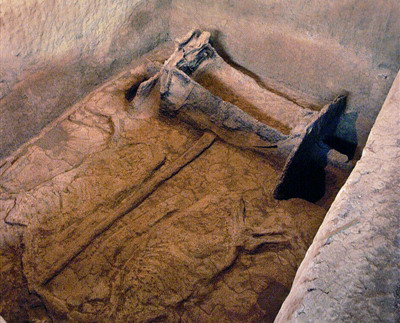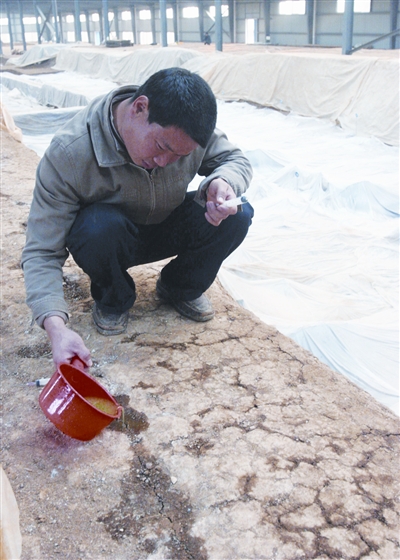 |
|
Remains of a chariot and two horses can be seen inside the tomb. [Wuhan Morning Post] |
Chinese archaeologists have reached a consensus that the master of a tomb dating back 2,400 years, was a king of the State of Chu in the Warring States Period (475 to 221 BC).
"The tomb is the largest and best preserved found to date from the State of Chu in the Warring States Period," Liu Binhui, an expert in Chu culture with the Hunan provincial museum, who had carried out research in Jingzhou for more than 20 years before transferring to Hunan, said.
The tomb has a 131-m-long horse and chariot chamber, the longest ever found from the period, the Wuhan Evening News reported yesterday.
Excavation of the chamber is about half complete, with 43 chariots and more than 100 horses unearthed, Liu said.
"Three chariots were equipped with six horses," he said.
"That reflects the rank of the tomb's owner. Only kings were allowed to drive chariots with six horses during the Warring States Period."
 |
|
An archaeologist is seen doing treatment to the tomb site. [Wuhan Morning Post] |
The consensus came at an archaeological forum dedicated to the discussion of the tomb's occupant on Wednesday after more than two years of excavation from the tomb compound, which is located in Jingzhou, Hubei province.
"All of the evidence leads to the conclusion that the tomb belongs to a king of the State of Chu," Liu said.
Meanwhile, archaeologists have also found 92 graves that might have been for people buried with the dead, a custom of the State of Chu, he said.
Since its discovery in 1979, archaeologists have identified the main mound, about 100 ancillary tomb tumuli, more than 30 horse and chariot pits arranged in a row and a surrounding ditch. Formal excavation started in August 2006, he said.
Ever since its discovery, archaeologists have shown great interested in the occupant of the tomb, which covers an area of 60,000 sq m.
More than 1,300 jade items were put on display in Jingzhou in September last year, the largest exhibition of jade articles in China.
Xu Wenwu, a professor with the Changjiang University, made an even bolder assumption.
"The great probability is that the tomb is of King Zhao of Chu, named Xiong Zhen, who was the last king of the state," he said.
In all, 11 kings ruled Chu.
(China Daily December 12, 2008)